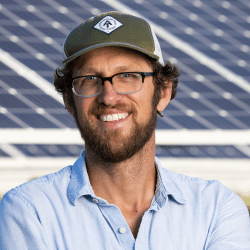Introduction
Jyoti Sharma is closing a generational gap in water resource management knowledge by developing a citizen-based water management system run by a competent, decentralized local authority. She involves stakeholders from the community, hydrology experts, business leaders, and local politicians in a process that enables communities to create local pockets of water security. Jyoti’s goal is to return ownership of water demand decisions to the community and build a network that is capable of self-regulating consumption. By grounding the process of conservation in the communities where water is a source of life, Jyoti is creating a new model of self-sufficiency for a resource that was formerly outside the control of citizens.
The New Idea
Jyoti’s organization, Forum for Organised Resource Conservation and Enhancement (FORCE), is creating community water management structures. She has built a portfolio of water conservation technologies that enables communities to see the impact that changing their consumption patterns can have on local water resources. FORCE has created the model for disseminating community-scale water conservation structures across India. For example, by introducing a rainwater catchment structure in a community that would serve 20 families Jyoti garners the support of other people in adjacent neighborhoods who also want to introduce catchment structures in their areas. The water conservation structures give the community a physical rallying point for further dissemination of conservation technology to individual households and behavioral conservation efforts on an individual level. To explain the reaction she is trying to elicit from people with respect to their responsibility to conserve a water resource, she relates a story about her father who grew up in rural India. He would have to jump from leaf to leaf in the summer when traveling to and from school because the ground was so hot. Jyoti explained that in the same way this experience of traveling to school would be foreign for her and her children, people are also a generation removed from how their families have dealt with the recognition of water as a precious resource and their need to conserve it.
Jyoti has combined technological interventions with a community governance structure that makes citizens responsible for consumption decisions. In order to build a citizen base of support for water conservation efforts, Jyoti begins her work at the community level where behavioral change can best be effected. The process of building the structures, surveying the neighborhood and encouraging citizens to invest in individual water saving technologies all change the consumption goals of a given locality. When citizens’ internalize the scarcity of water they also begin to access latent traditional methods for individual water conservation. Jyoti has seen her introduction of FORCE conservation technologies stimulate a community’s ability to remember water conservation techniques that were lost a generation ago.
Jyoti sustains a community’s choice to change consumption goals by recruiting Jal Rakshaks (Water Guardians) in every community where FORCE works. Jal Rakshaks are defined by their leadership in water conservation efforts but more importantly by their ability to organize a community around lasting change in consumption patterns. The Jal Rakshaks is the point of contact for FORCE and enables the organization to spread the message of water conservation and stewardship effectively to other communities. FORCE supports the work of Jal Rakshaks in over 250 locations through partnerships with private industry, local governments, technical experts, and media. Jyoti has brought together disparate parts of the water conservation community as part of her approach to spreading not only the technological interventions but a broader strategy to support lasting change in local participation in water management.
The Problem
With the rise of the centralized nation state in India, people have experienced a slow erosion of their own local water management capability. City governments have supplanted community management of water resources areas and people are a generation removed from knowledge of water self-sufficiency. Citizens are not provided with the information and conservation tools necessary to manage their community’s demand for water. There is a lack of resource ownership that causes citizens to be apathetic about their water access. Apathy about water access is augmented by a lack of redress to the central water authority, which acts like a large modern bureaucracy when handling citizen complaints. Without organization and oversight tools to collect systematic information on sources of inefficiency in the distribution network, the central water authority in urban areas cannot identify problems in the transmission network, much less inform people about their own consumption patterns.
Today water is a public good that is shared in common ownership and managed by city-wide authorities who are supposed to charge rates that reflect the “essential commodity” nature of this resource. The Central Water Authority has repeatedly failed to transmit the message of savings through conservations with citizens because they have not done the majority of the field work necessary to identify and quantify the points of most intense consumption. In rapidly growing residential areas, citizens rarely get access to information about how their consumption patterns affect the community and long-term water security. Information on water supply is also not easily accessible at a level where people can take action in their own communities. The closer that potable water distribution networks get to the end user in urban India, the more of the water resources are wasted in poor infrastructure, illegal siphoning, and misguided management decisions. Communities that do not get enough water through the public distribution system will often resort to drilling their own bore wells to supplement their already limited ration. The uncoordinated drilling of bore wells depletes the underground water table and jeopardizes the source for future generations. People make choices about consumption in absence of this information and endanger the water security of their community. As people use water during peak consumption periods or drill new wells to support increasing demand, they make decisions that satisfy a desire while creating problems for the community and their own long-term interests. The lack of coordination leads to, and exacerbates, a lack of ownership for the problem of water scarcity that is masked by the distribution system in general.
The Strategy
FORCE is solving the problem of local water resource management by taking communities through a process by which they realize the impact they can have on resource conservation and the need for it. The magnitude of the water management problem at an urban level can be daunting, therefore, FORCE breaks down the larger system solutions to a level where the community can act. At this initial stage of working with a community, Jyoti starts with the resident welfare associations and builds four-way partnerships among the associations, technical experts, corporations with an interest in supporting such neighborhood development as part of their corporate social responsibility (i.e. sometimes because employees or relatives live there), and local politicians who may want to improve their image and have the power to help the model spread.
Jyoti brings in data about how local water management projects have helped communities in the past and demonstrates a clear potential to save water in the neighborhood. She begins by conducting a survey of the residential area where the community has identified a water shortage problem. This process involves bringing technical experts into the neighborhood to do site surveys and collect information on the way water flows through public spaces. The experts identify sources of inefficacy in consumption, distribution, and collection of community water resources. Using the site surveys, FORCE then recommends a package of technologies and management practices that will reduce the neighborhood’s water consumption footprint and gives them the ability to recharge ground water holdings. The technologies that she introduces include setting up rainwater catchment systems, modifying pipe drains with shutter filters, recharging abandoned tube wells, and angled filter screens for drain pipes. Maintenance and improvements to the physical plant are monitored by a system that is operated by the community. These technologies are a catalyst for a larger community conversation about how to rationalize water demand and create management systems where consumption ownership is clearly defined. Jyoti has found that this conversation, which takes place at the community level, helps people to realize the easy solutions to everyday water problems.
When the water saving devices are installed, Jyoti introduces the final layer of her partnership model by holding a large gathering to inaugurate the project. All four members of the partnership are always present. She brings in media coverage and invites the local legislators to take ownership of the project moving forward. By involving them, Jyoti ensures that FORCE has greater leverage going into the next community because politicians will be more inclined to hand local demand management over to the resident welfare associations and get them to engage more actively with the larger political bureaucracy. Jyoti includes present and potential supporters from the business community to take part in the inauguration ceremony. She counts on their support to continue developing new water conservation technologies and to contribute to the maintenance costs of existing projects over the long-term.
The city-wide water planning administrators are also involved in the FORCE process through advocacy work around changing the subsidy patterns of catchment systems. The water planning board had a policy whereby resident welfare associations would be reimbursed for a rain water harvesting structure only after the entire structure was completed and if the structure met with the specifications given by the Central Ground Water Board (CGWB). Often delayed inspections by the CGWB led to applications being rejected because of deviation from exact CGWB specs due to silting of structures or natural wear and tear. This became a disincentive for the community to undertake construction of rain water harvesting structures. After FORCE’s intervention the rule has been changed, now 50 percent of the total reimbursement can be claimed as soon as the structure is complete. The remaining reimbursement is contingent on compliance with completion criteria. Jyoti wishes to introduce a progressive tax on electric water pumps and has gotten legislation passed that creates a permitting process for new bore well drilling. In order to support the long-term work that FORCE is doing, Jyoti has realized that she needs some buy-in from the Central Water Board to connect the pockets of abundance that she is creating at a local level into a network of plenty. By bringing all these players to the inauguration events for conservation projects she builds synapses where water conservation is the focus of conversation. Her combination of private business, local government, community members, and technical experts strength’s in rallying for local water conservation efforts is maintained by a clearly defined system of incentives and responsibilities that apply to all new partnerships created as the work spreads.
In order to manage a large network of communities spread out across India Jyoti has recruited a network of Jal Rakshaks to act as organizers in each neighborhood and be the contact for FORCE. Jal Rakshaks have usually held leadership roles in the community but FORCE builds a component of conservation leadership into their existing work as organizers. When identifying Jal Rakshaks, Jyoti only has two requirements: The person have some experience with leadership in the community where they work, and they have some track record of water issue awareness. Jyoti works with other local citizen organizations and community leaders to identify Jal Rakshaks candidates, thus strengthening her partnership with the community members where she is building the conservation structures. The Jal Rakshaks also act as distribution points for FORCE technologies to individual homes and adjacent communities. In the future Jyoti envisions that Jal Rakshaks and other community members can develop small businesses selling the conservation catchment tools that FORCE is designing with input from its client communities. This will be income for them and the profits will not accrue to FORCE. So far Jyoti has built a network of over 200 Jal Rakshaks in over 250 communities across the greater New Delhi area. FORCE’s 14 member staff has also identified 20 slum areas where two Jal Rakshaks are currently working on sustainable water and sanitation for the poor. Jyoti also works with young people in university settings to organize them around water issues and build the next generation of Jal Rakshaks. The Jal Rakshaks serve as stewards of conservation efforts in their own communities and also as scale agents for FORCE as they disseminate the technologies to other communities. Her work has spread to Mumbai, Bangalore, Jaipur, Noida, Ghaziabad, and Gurgaon. Jyoti is also working with 22 Air Force Stations in North India and wants to take her work across the country in the next five years.
The Person
Jyoti was born in Delhi and studied economics in college. She went on to do her MBA from Indian Institute of Management, Bangalore and worked in the corporate sector for eight years. After she was asked to conduct a very in-depth analysis of why comparable washing machines would be better for a consumer during a marketing campaign, Jyoti was struck by the emptiness of the work she was doing in the private sector. After leaving the private sector she began teaching at a business school. Earlier in her life Jyoti felt that only wealthy people could afford the luxury of working on social problems. However, an experience of parents getting angry with one another while waiting for their (and her) children’s school bus during a water shortage, and a report on water crisis prepared by one of her students catalyzed what she has come to see as a life work around water conservation. Initially Jyoti began working with the CGWB but soon realized that she must institutionalize her work if things were to expand to a larger scale, so she set up FORCE in 2004.
To explain the reaction she is trying to elicit from people with respect to their responsibility to conserve a water resource, she relates a story about her father who grew up in rural India. He would have to jump from leaf to leaf in the summer when traveling to and from school because the ground was so hot. Jyoti explained that in the same way this experience of traveling to school would be foreign for her and her children, people are also a generation removed from how their families have dealt with the recognition of water as a precious resource and their need to conserve it.



